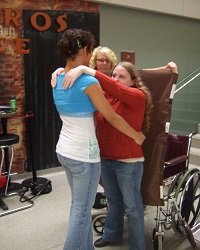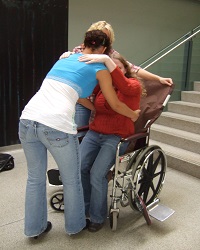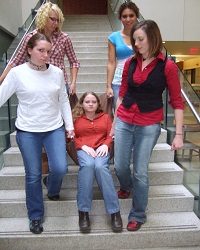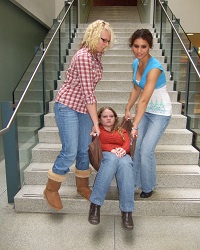TUK-’N-KARI™ Instructions and Transfer Procedures
Moving a disabled person with partial mobility from a wheelchair to a TUK-’N-KARI™ involves these simple transfer procedures:
Please Follow These Steps:
- Lock the wheelchair wheels and swing the foot and/or leg rests to the side of the wheelchair.
- Scoot the disabled person forward enough so their bent knees are an inch or two forward of the front of the wheelchair.
- Have the handicapped person grasp their own hands behind the helper’s neck while the helper reaches around the torso of the handicapped person. (a transfer belt could be used if both are more comfortable with it) The helper’s feet need to be planted firmly on the floor, knees bent and back as straight as possible. The helper lifts the handicapped person by straightening their knees while lifting with their arms.
- When the handicapped person is in a standing position, a second helper drops the TUK-’N-KARI™ behind the handicapped person with the TUK-’N-KARI™ handles facing toward the lifter. For head support, the TUK-’N-KARI™ should drop no lower (could be higher) than the handicapped person’s ear level and, especially, no lower than the top of their knees.
- Set the handicapped person back down on to the wheel chair and on to the TUK-’N-KARI™.
- Helpers (two or four) grasp each handle, lift with their arms and move toward the front of the wheelchair. Whether going up or down stairs, the helpers must make sure the disabled person is always facing the bottom of the stairs and grasp the handles with left or right hands accordingly.
- Navigate the steps or any obstacle with back and arms straight. Make sure the disabled person’s “bottom” does not bump the steps.
TUK-’N-KARI™ Transfer Procedures For Totally Disabled People
Moving a disabled person with no mobility from a wheelchair to a TUK-’N-KARI™ involves these simple transfer procedures. Just follow these steps.

- One helper holds the TUK-’N-KARI™ horizontally with the handles facing toward them. Grasp the TUK-’N-KARI™ a few inches inside the handles. With their fingers, gather the TUK-’N-KARI™ with both hands and stop at the middle.
- When the wheelchair wheels are locked and foot/leg rests swung out of the way, two helpers place their toes on the bottom of the wheel rim to help stabilize their wheel chair.
- A second helper rolls the handicapped person toward their side while the first helper tucks the TUK-’N-KARI™ under the handicapped person, stopping at their center back. Release the TUK-’N-KARI™.
- Roll the handicapped person to their other side and on to the flat portion of the TUK-’N-KARI™.
- While the handicapped person is on their second side, helper two flattens the gathered half of the TUK-’N-KARI™.
- Make sure the TUK-’N-KARI™ is no lower than ear level (could be higher) for head support and falls no lower than the top of their knees.
- Helpers grasp each handle, lift, and move toward the front of the wheel chair.
TUK-’N-KARI™ Transfer Procedures For People With Partial Mobility
Moving a disabled person with partial mobility from a wheelchair to a TUK-’N-KARI™ is a simple procedure. Please follow these steps.
1. Lock the wheelchair wheels and swing the foot and/or leg rests to the side of the wheelchair.
2. Scoot the wheelchair user forward enough so their bent knees are an inch or two forward of the front of the wheelchair.
 |
3. Have the handicapped person grasp their own hands behind the companion’s neck while the companion reaches around the torso of the handicapped person. (a transfer belt could be used if both are more comfortable with it) The companion’s feet need to be planted firmly on the floor, knees bent and back as straight as possible. The companion lifts the handicapped person by straightening their knees while lifting with their arms. |

4. When the handicapped person is in a standing position, a second companion drops the TUK-’N-KARI™ behind the handicapped person with the TUK-’N-KARI™ handles facing toward the lifter. For head support, the TUK-’N-KARI™ should drop no lower (could be higher) than the handicapped person’s ear level and, especially, no lower than the top of their knees.

5. Set the handicapped person back down on to the wheel chair and on to the TUK-’N-KARI™.

6. Companions (two or four) grasp each handle, lift with their arms and move toward the front of the wheelchair. Whether going up or down stairs, the companions must make sure the disabled person is always facing the bottom of the stairs and grasp the handles with left or right hands accordingly.



7. Navigate the steps or any obstacle with back and arms straight. Make sure the disabled person’s “bottom” does not bump the steps.
8. Reverse this process when returning to the wheelchair.